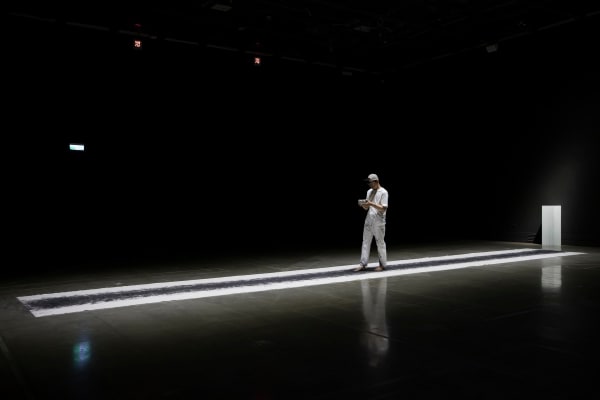"Ink Walking" is a performance work inspired by two sources: a Buddhist story from the "Sutra on the Stages of Yoga Practice", in which a king grants a condemned man a chance to escape execution—if he can carry a bowl filled to the brim with oil from the north gate to the south gate of the city without spilling a single drop—and a scene from Andrei Tarkovsky’s film "Nostalgia", in which the protagonist lights a candle and walks slowly across a drained thermal pool.
Performance art often operates according to its own internal logic—its structure, rules, and duration all contribute to its aesthetic and conceptual meaning. In this work, the artist replaces the oil with ink. Holding a full bowl of ink, he walks back and forth across a long strip of white cloth. Each time the ink spills or the liquid level drops, he replenishes it with clear water and continues walking. The performance ends only when the entire bowl has become filled with clear water.
As the performance unfolds, the stains and footprints left on the white cloth shift gradually from dense black to pale gray, until finally, with only water remaining, there are no visible traces. Through this symbolic yet physically enacted process, Shi Jin-Hua speaks to the essence of both spiritual cultivation and ink art: that the goal is not to control external outcomes, but to sustain clear, steady awareness—to return the mind to its original, unburdened state.
In this work, the bowl represents the mind. To carry it is to practice holding the mind: first in concentration, then in awakened attention. The ink symbolizes the three poisons—greed, anger, and delusion—as well as other karmic tendencies that obscure inner clarity. The act of refilling the bowl with water reflects an aspiration toward purification and the persistence required to sustain it. The ground cloth becomes both a path and a site of practice, a "Bodhimaṇḍa" (place of awakening), where the footprints and stains represent past karma that slowly fades with disciplined effort.
This “bowl-walking” may be understood as a form of walking meditation. The artist establishes the parameters himself: to walk the length of white cloth holding a full bowl of ink, replenishing it with water whenever needed. The performance ends when the transformation is complete, and the ink has become pure water.
《墨行》是一件行為藝術,它啟發自《修行道地經》佛說一國王要求死囚持一满缽油,自北門行至南門,不得溢出一滴油定其生死的故事 ,以及安德列塔可夫斯基的電影《鄉愁》男主角點燃蠟燭橫渡乾涸溫泉池的那一幕。
行為藝術通常有其內在邏輯自定的規則,怎麼行為,何時開始與結束都指向其美學意義。藝術家將經文滿缽的油改為墨汁,擎缽往復步行於一條白布之上,缽內的墨汁每有溢出減少下降,就兌入清水補滿,然後繼續行走,一直到整碗缽成為清水,行為結束。這塊白布上的墨跡、足跡由深黑至淺淡,終於成為沒有痕跡的清水。在這裡,藝術家以具體的歷程但象徵的方式,點出修行與水墨藝術的本質與要義,即鍛鍊的核心並不是外在的現象與最後的結果,而是時時專注地維持清淨的覺知,讓心回到他本來自在的樣子。
在這件作品裡,「缽」即是心,持缽就是修習持心,先是練心的專注,然後是用上覺醒的心。
「墨」,可以象徵污染本心的三毒、惡習氣。用「水與水瓶」不斷給缽注水,象徵淨化的心願與持續的操行。「地布」是到彼岸的道,它同時也是一個道場,而布上斑斑點點的墨跡與足印,則象徵過去積澱的惡業。「持缽行」算是一種行禪吧。持缽人自訂規矩,要在一條白布上持一滿缽的墨來回行走,缽中墨只要溢出降低,就兌水注滿,而這個行為的結束時間,就定在缽中液體成為淨水的那一刻。
Performance art often operates according to its own internal logic—its structure, rules, and duration all contribute to its aesthetic and conceptual meaning. In this work, the artist replaces the oil with ink. Holding a full bowl of ink, he walks back and forth across a long strip of white cloth. Each time the ink spills or the liquid level drops, he replenishes it with clear water and continues walking. The performance ends only when the entire bowl has become filled with clear water.
As the performance unfolds, the stains and footprints left on the white cloth shift gradually from dense black to pale gray, until finally, with only water remaining, there are no visible traces. Through this symbolic yet physically enacted process, Shi Jin-Hua speaks to the essence of both spiritual cultivation and ink art: that the goal is not to control external outcomes, but to sustain clear, steady awareness—to return the mind to its original, unburdened state.
In this work, the bowl represents the mind. To carry it is to practice holding the mind: first in concentration, then in awakened attention. The ink symbolizes the three poisons—greed, anger, and delusion—as well as other karmic tendencies that obscure inner clarity. The act of refilling the bowl with water reflects an aspiration toward purification and the persistence required to sustain it. The ground cloth becomes both a path and a site of practice, a "Bodhimaṇḍa" (place of awakening), where the footprints and stains represent past karma that slowly fades with disciplined effort.
This “bowl-walking” may be understood as a form of walking meditation. The artist establishes the parameters himself: to walk the length of white cloth holding a full bowl of ink, replenishing it with water whenever needed. The performance ends when the transformation is complete, and the ink has become pure water.
《墨行》是一件行為藝術,它啟發自《修行道地經》佛說一國王要求死囚持一满缽油,自北門行至南門,不得溢出一滴油定其生死的故事 ,以及安德列塔可夫斯基的電影《鄉愁》男主角點燃蠟燭橫渡乾涸溫泉池的那一幕。
行為藝術通常有其內在邏輯自定的規則,怎麼行為,何時開始與結束都指向其美學意義。藝術家將經文滿缽的油改為墨汁,擎缽往復步行於一條白布之上,缽內的墨汁每有溢出減少下降,就兌入清水補滿,然後繼續行走,一直到整碗缽成為清水,行為結束。這塊白布上的墨跡、足跡由深黑至淺淡,終於成為沒有痕跡的清水。在這裡,藝術家以具體的歷程但象徵的方式,點出修行與水墨藝術的本質與要義,即鍛鍊的核心並不是外在的現象與最後的結果,而是時時專注地維持清淨的覺知,讓心回到他本來自在的樣子。
在這件作品裡,「缽」即是心,持缽就是修習持心,先是練心的專注,然後是用上覺醒的心。
「墨」,可以象徵污染本心的三毒、惡習氣。用「水與水瓶」不斷給缽注水,象徵淨化的心願與持續的操行。「地布」是到彼岸的道,它同時也是一個道場,而布上斑斑點點的墨跡與足印,則象徵過去積澱的惡業。「持缽行」算是一種行禪吧。持缽人自訂規矩,要在一條白布上持一滿缽的墨來回行走,缽中墨只要溢出降低,就兌水注滿,而這個行為的結束時間,就定在缽中液體成為淨水的那一刻。
